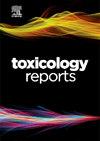孟加拉国家禽饲料和肉鸡中的重金属污染
Q1 Environmental Science
引用次数: 0
摘要
家禽业对孟加拉国人民构成严重的重金属中毒威胁。进行这项研究是为了评估鸡饲料以及家禽的其他可食用部分中的重金属水平,并确定可能涉及的健康危害。对从拉杰沙希市几个当地市场获得的16种市售家禽饲料和3种可食用鸡肉中的7种金属含量进行了评估。采用湿消解法,用原子吸收分光光度计测定了金属的浓度。家禽饲料中Cr、Cd、Pb、Cu、Mn、Ni、Fe的含量分别为0.03 ~ 12.85 mg/kg、0.01 ~ 1.64 mg/kg、0.15 ~ 4.21 mg/kg、2.65 ~ 45.83 mg/kg、22.63 ~ 188.85 mg/kg、0.09 ~ 2.64 mg/kg和0.54 ~ 41.01 mg/kg。肉鸡的浓度分别为0.87 ~ 3.15 mg/kg、0.01 ~ 0.05 mg/kg、0.19 ~ 1.09 mg/kg、0.96 ~ 3.78 mg/kg、4.45 ~ 23.53 mg/kg、0.07 ~ 0.56 mg/kg和2.70 ~ 92.32 mg/kg。除铜、锰和铁外,鸡体内大多数重金属浓度均超过粮农组织/世界卫生组织规定的最高允许浓度。经检测的所有金属的EDI、THQ和TTHQ估计值均低于MTDI,这表明食用鸡肉对个人没有致癌风险。相比之下,与Cd和Pb相关的ILCR在安全阈值附近,但Cr超出了允许范围,具有显著的风险。本文章由计算机程序翻译,如有差异,请以英文原文为准。
Heavy metal pollution in poultry feeds and broiler chickens in Bangladesh
The poultry industry poses a significant threat of heavy metal poisoning for the people of Bangladesh. The research was performed to assess the levels of heavy metals in chicken feed as well as other consumable sections of poultry fowl, and to determine the possible health hazards implicated. The levels of seven metals were evaluated in sixteen commercially available poultry feeds and in three edible portions of chicken obtained from several local markets in Rajshahi city. The metal concentrations were investigated via an atomic absorption spectrophotometer following the wet digestion method. The amount of Cr, Cd, Pb, Cu, Mn, Ni, and Fe in poultry feeds were observed from 0.03 to 12.85 mg/kg, 0.01–1.64 mg/kg, 0.15–4.21 mg/kg, 2.65–45.83 mg/kg, 22.63–188.85 mg/kg, 0.09–2.64 mg/kg, and 0.54–41.01 mg/kg, respectively. In broiler chickens, the concentrations were determined from 0.87 to 3.15 mg/kg, 0.01–0.05 mg/kg, 0.19–1.09 mg/kg, 0.96–3.78 mg/kg, 4.45–23.53 mg/kg, 0.07–0.56 mg/kg, and 2.70–92.32 mg/kg, respectively. With the exception of Cu, Mn, and Fe, most heavy metal concentrations in chickens exceeded the highest allowed concentration set by FAO/WHO. The estimated EDI, THQ and TTHQ numbers for all metals examined were found to be below MTDI, indicating that consumption of chicken meat poses noncarcinogenic risk to individuals. Comparatively, ILCR associated with Cd and Pb are around the safety threshold, but Cr exceeds the permissible range and poses a significant risk.
求助全文
通过发布文献求助,成功后即可免费获取论文全文。
去求助
来源期刊

Toxicology Reports
Environmental Science-Health, Toxicology and Mutagenesis
CiteScore
7.60
自引率
0.00%
发文量
228
审稿时长
11 weeks
 求助内容:
求助内容: 应助结果提醒方式:
应助结果提醒方式:


